A Ghost Dance in the Ripples of a Well Cradle
Jun Tanaka’s Aby Warburg: The Labyrinth of Memory (Tokyo 2001)
Introduced and edited by Emily Verla Bovino
Abstract
Japanese Warburg scholar Jun Tanaka’s Reflections on Aby Warburg and Japanese Theatre.
Featuring an English extract from Jun Tanaka’s “Acknowledgments” introduction to Aby Warburg: Kioku no Meikyu (= Aby Warburg: The Labyrinth of Memory). Tokyo: Seido-sha, 2001
In the penultimate chapter of Aby Warburg and the Image in Motion (1998; 2004), art historian and film curator Philippe Alain-Michaud returns to Aby Warburg’s youth to recount the Hamburg scholar’s last minute decision not to cross the Pacific in 1896, but to remain in the American Far West. Transitioning between book chapters, a brief interlude by Michaud suggests readers imagine Warburg had instead followed his planned travels to Japan with a desire to see Kabuki theatre (Michaud, 271-272). How might Warburg’s thought about the Pathosformeln (pathos formulas) have developed had he discovered the performance of Mie, the dramatic poses in which “[t]he Kabuki actor (…) immobilized at the height of gestural intensity” captures himself – often while playing a woman – enrapt in “a movement frozen in the instant of its greatest intensity?” (272). What ideas about world history would Warburg’s later retrospective musings (1923) based on the American travels of his youth (1896) have evoked if his observations of Pueblo animal dances in the monumental landscapes of New Mexico and Arizona had been complimented by watching Kabuki bodies become pictures in Yokohama’s theatres? Warburg himself left behind traces of the possibilities in his Atlas project, Mnemosyne (1924 – 1929): the third prologue plate to the Atlas, Plate C, includes a newspaper illustration copied from a photograph of the German Graf Zeppelin flying over the Japanese coast in 1929 (fig.1 left); Plate 79, the last plate in Warburg's incomplete project, includes a staged photograph of hara-kiri (Japanese ritual suicide) from a French book on Japanese history (1899) and an illustration of body parts mapped for a book on Imperial Japanese punishments and executions (1897) (fig. 1 right).
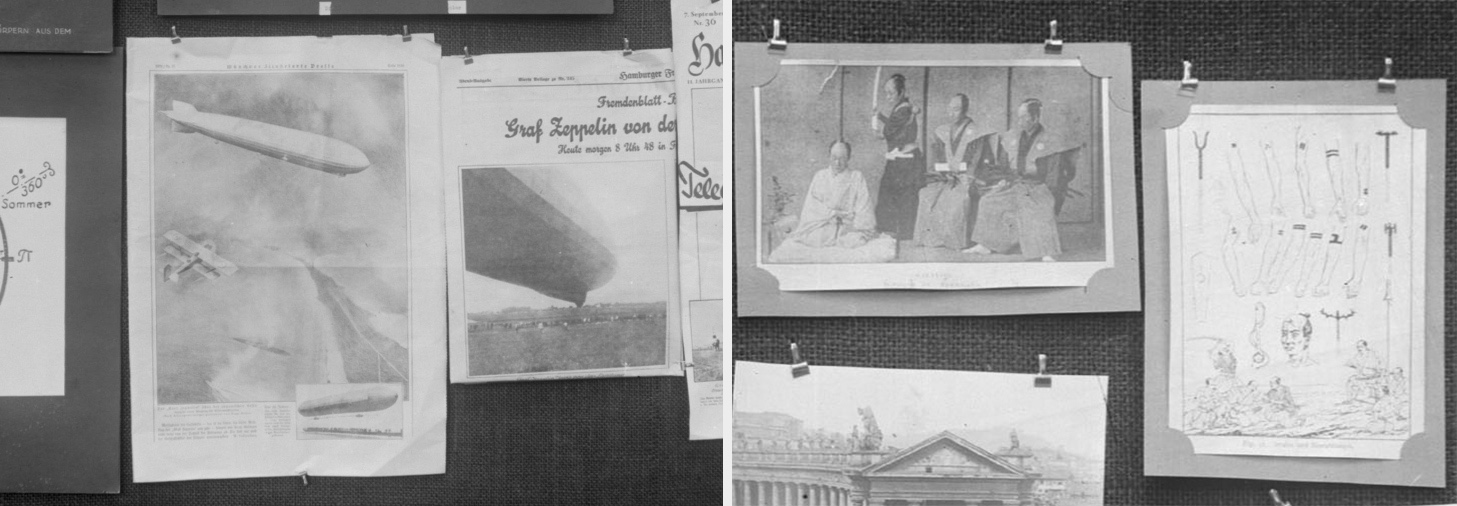
Fig. 1 left: detail of Plate C in Aby Warburg’s Mnemosyne with newspaper cut-out from Münchner Illustrierte Presse, No. 35, 1929: original caption reads “The Graf Zeppelin over the Japanese coast encounters a plane of the coastal defense. (Drawn by Hugo Huber from newspaper reports). Fig. 1 right: detail of Plate 79 in Warburg’s Mnemosyne with a photograph of staged (left) Harakiri from Antoine Rous’ Essais sur l’histoire du Japon (Paris, 1899) and (right) schematic drawings of “Punishments and Executions” from Philipp Franz von Siebold’s Nippon. Archiv zur Beschreibung von Japan und dessen Neben- und Schutzländern, 1897. For the full plates, consult Engramma’s online edition of Mnemosyne Atlas. (Image source: Warburg Institute, London)
In the following extract selected for publication in Engramma from Japanese Warburg scholar Jun Tanaka’s “Acknowledgments” introduction to his 2001 book on Warburg – Aby Warburg. Kioku no Meikyu (Aby Warburg: The Labyrinth of Memory) – Tanaka, an intellectual historian and historian of art, poses the same speculative scenario as Michaud. Interestingly, however, Tanaka’s associations do not lead him to Kabuki theatre, but to the theatre of Noh. These two forms of Japanese classical theatre - Kabuki and Noh - are commonly defined in opposition by way of a series of irreconcilable polarities that would undoubtedly have interested Warburg: it is said that “noh is austere, kabuki flamboyant; noh ritual, kabuki spectacle; noh offers spiritual consolation, kabuki physical excitement; noh seeks chaste models, kabuki delights in the eccentric, the extravagant and the willfully perverse; noh is gentle, kabuki cruel; noh is concerned with the hereafter, kabuki bound by the here-and-now.” (Arnott quoted in Kuritz 1988, 103). It could therefore be said that between Tanaka’s Noh and Michaud’s Kabuki lies a problem of energy between two temporalities - a concern with the hereafter in Noh, and a being bound to the here-and-now in Kabuki. In the energetic tension in the middle of this problem in between, Warburg’s conceptualization of Nachleben (afterlife) charged Pathosformeln does indeed resound.
Like Michaud’s what-if scenario, Tanaka’s association between Noh and the Pathosformeln that Warburg traced in Mnemosyne, leads to broader assertions about Warburg’s work: contemporary interest in “simulating Mnemosyne using pre-existing information technology is not enough,” Tanaka writes (Tanaka 2002). Rather than simply aspiring to make digital versions of Mnemosyne, “we should be thinking of how (…) the very feel of the "appearance" and "metamorphosis" of information itself --- may be transplanted into the computer interface” (Tanaka 2002). For Tanaka, a specific scene in a particular Noh drama, Isutzu (The Well Cradle), is a synechdoche for precisely the “very feel of the “appearance” and “metamorphosis” of information” he has in mind (Fig. 1). The slight shuffling feet and quiet masked stasis that constitute the Noh performer’s body in this scene contrast sharply with the explosive freezing of the Mie Michaud cites, and yet there is something disquietingly similar about the interval of stillness produced by the gender-bending actors in both. It therefore does not seem strange that Tanaka proposes the Mie-like penetrative action of “transplanting,” and the invasive embracing of “interface,” to counteract passionless “simulating” of Mnemosyne. As Tanaka explains in an unpublished summary to his book on Warburg,
Warburg interwove his own passion into his inquiries (…). In other words, his inquiries were both historical research and auto-biography. Thus any attempt to trace Warburg's thought entails deciphering the confusion that fills cultural memory from origin. This process must take place on the stage that was Warburg's own suffering body, and it takes place within a movement from auto-biography to the history of European culture or vice-versa, or perhaps more appropriately in the fierce mutual infiltration of the two (Tanaka Summary).
Studied alongside this passage, the hara-kiri photograph in the concluding plate of Mnemosyne, Plate 79, is a mise-en-abime for Tanaka’s image of the self-metonymizing historian: the historian’s body suffers being transformed into an anatomical theatre of memory under the self-dissection of its own image associations as historical symptoms.
In 2012, Tanaka organized the exhibition MNEMOSYNE ATLAS: Aby Warburg’s Cosmos of Images on the Komaba campus of the University of Tokyo. The exhibition featured large display reproductions of all sixty-three plates of the final version of Mnemosyne photographed in 1929. The prints were mounted on mobile aluminum panels arranged in a series of winding corridors under flourescent ceiling circles. The show included what announcements for the exhibition as “three new MA[Mnemosyne Atlas]-like panels” and a “Mnemosyne Atlas Performance” with music and dance. This presentation of Warburg’s Mnemosyne was the first of its kind in East Asia, since followed by Georges Didi-Huberman’s current Memory Burns (2015), an iteration of Didi-Huberman’s itinerant Atlas exhibition (2011 and ongoing) created for the OCAT Institute in Beijing. Like Didi-Huberman’s heroic devise of Warburg as the historian-as-pearl-diver (Didi-Huberman [2002] 2006, 466), in Tanaka’s emblem of the psychohistorian-as-wandering-monk, or waki (Tanaka 2002), Warburg’s work interknotting passion with inquiry, and pictures as objects with body as memory, is a new materialism for intellectual history with new tools of estrangement and new technologies of the self.
Jun Tanaka (b. 1960) is a professor of urban studies, art and intellectual history in the department of Interdisciplinary Cultural Studies at the University of Tokyo. His dissertation in art history from the University of Tokyo focused on avant-garde art and architecture in the interwar period in Germany. He is an alumnus of the Humboldt Universität zu Berlin, Institut für Kulturwissenschaft, and was awarded Germany’s prestigious Philipp Franz von Siebold Prize for Japanese Researchers in 2010. He is among the editors of the Mnemosyne Atlas supplement to the Japanese edition of Warburg’s Gesammelte Schriften (Collected Works) (Munemoshune atorasu; Varuburuku chosakushu, 2012). He is the author of numerous books including Urban Poetics: Analyses of Urban Representation, 2007, and Political Aesthetics: Power and Representation, 2008, as well as volumes on both Aby Warburg and Swiss futurist Gilbert Clavel (1888 – 1927). [EVB]
Bibliography
- DIDI-HUBERMAN [2002] 2006
Didi-Huberman, Georges. L’Immagine Insepolta: Aby Warburg, la memoria dei fantasmi e la storia dell’arte. Trans. Alessandro Serra. Torino: Bollati Boringhieri, 2006. - KURITZ 1988
Kuritz, Paul. The Making of Theatre History. New Jersey: Prentice Hall, 1988. - MICHAUD [1998] 2004
Michaud, Philippe-Alain. Aby Warburg and the Image in Motion. Trans. Sophie Hawkes. New York: Zone Books, 2004. - TANAKA 2001
Tanaka, Jun. Aby Warburg: Kioku no Meikyu (= Aby Warburg: The Labyrinth of Memory). Tokyo: Seido-sha, 2001. - TANAKA Summary
Tanaka, Jun. Unpublished Summary. Undated. - TAMURA 2013
Tamura, Yoshiya. “The English Essays of Minakata Kumagusu – Centering on his Contributions to Nature.” Japan Policy Forum. No. 16. October 7, 2013. Web.
Translated extract from Jun Tanaka’s “Acknowledgments” introduction to Aby Warburg: Kioku no Meikyu (= Aby Warburg: The Labyrinth of Memory). Tokyo: Seido-sha, 2001.
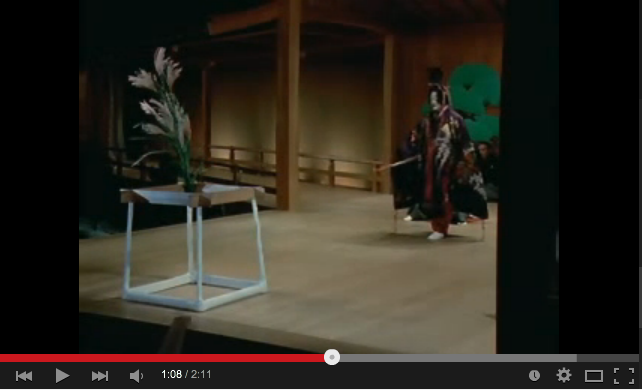
Fig. 2 The ghost of the daughter of Ki-no-aritsune dressed as a man peers into a well and recalls the image of her lover, Ariwara-no-narihira, in her own image. From the Zeami Noh play Izutsu as performed for the Japanese international broadcast corporation, NHK, 2006 Image Source: NHK.
The collection of images in Aby Warburg's Mnemosyne, a project undertaken in his late years, reminds us of the image on the screen of a computer monitor. It is as if today's information technology has allowed this visual atlas to discover the mode of expression appropriate to it. Attempts to bring the visual materials to life in computer databases and presentation software in the similar way to Mnemosyne already exist. However, the Mnemosyne panels remind me of yet something else: a scene from the Zeami Noh play Izutsu (Fig. 2). In this scene, the ghost of the daughter of Ki-no-aritsune appears, dressed as a man. At the end of a dance sequence, she peers into a well and recalls the image of her lover, Ariwara-no-narihira, in her own reflection in the surface of the water. The well can only be a distortion of Narcissus's spring, and if the surface reflecting the woman's image is the present, the water's depths beneath it are the past. Does this temporal structure recall the black screen of Mnemosyne, in which the ghosts of image-memories appear one after the other from the shadows in which the history of Europe and Warburg's personal history lie entangled? Mnemosyne is not an image-information database that has been rationally constructed from the blank page, but a fantastic ghost story. Simulating Mnemosyne using pre-existing information technology is not enough. Rather, we should be thinking of how the modification of the multiple similar images that bear down on us from every direction – the very feel of the "appearance" and "metamorphosis" of information itself – may be transplanted into the computer interface (Fig. 3).
Mnemosyne is the dance of the ghosts called images that appeared before Warburg's eyes, and Warburg himself the travelling monk, or waki, of Noh plays, just as the Lecture on Serpent Ritual directed by Warburg, who was revisiting the American West in his memories, resembled the half-dream, half-reality two-part Noh plays about apparitions known as "fukushiki mugen Noh". Warburg desired to cross time and space and travel in all directions, and was devoted to placing memory, the "time" of the past, in the space called "place". As the designation "atlas" demonstrates, each of the Mnemosyne panels was a topos in which the memories of special images were buried. In the Lecture on Serpent Ritual, the replay of memories asleep in the specific earth known as North America set off a chain reaction of images from classical times to the present.
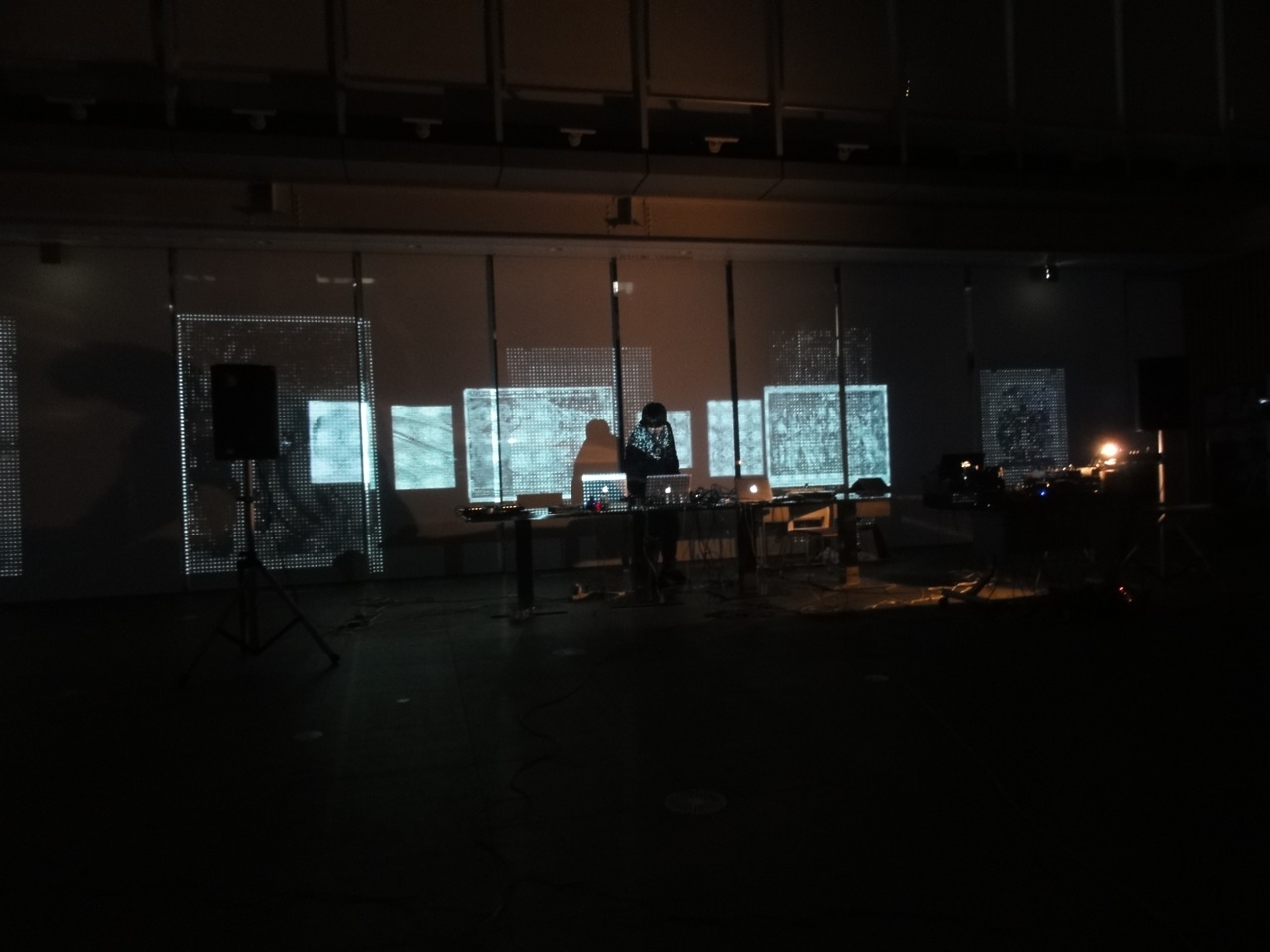
Fig. 3 Photograph of the “Mnemosyne Atlas Performance” organized by Jun Tanaka at the University of Tokyo in 2012. Image source: University of Tokyo.
So, what memories would the topos called Japan recall for Warburg? According to Dr. Dorothea McEwan of the Warburg Institute, Warburg had made plans to visit Japan while staying in San Francisco in 1896. He even got as far as reserving a berth on the SS China, leaving for Yokohama on March 14, before cancelling his trans-Pacific travels just prior to departure. This was because he would have returned from Japan to the United States in the summer. Not only was the summertime too hot to visit Hopi villages in Arizona, but it was also pollen season, and Warburg a chronic sufferer of hay fever. Incidentally, his brother Paul had already visited Japan in 1893.
Had Warburg visited Japan the year after its victory in the Russo-Japanese War, what would he have found there? Would he have directed his anthropologist's gaze on Noh and the other traditional Japanese art forms as he directed it on Native Americans? Or perhaps he would have discovered the coexistence of advanced technology with customs that seemed "primitive" from a European eye in a national culture that was seeking to build a modernized empire through the "grafting" of the West into the East, and winced at the difficulties of interpreting this strange palimpsest. Whichever, the last panel of Mnemosyne, in which appears the image of a Japanese man, shows that he continued to have an interest in Japan. Minakata Kumagusu, Japanese folklorist and biologist, worked at the British Museum in London during the period of Warburg's travels in the United States (Fig. 4). I cannot help but imagine what could have happened if these two men, so close in age, had met.
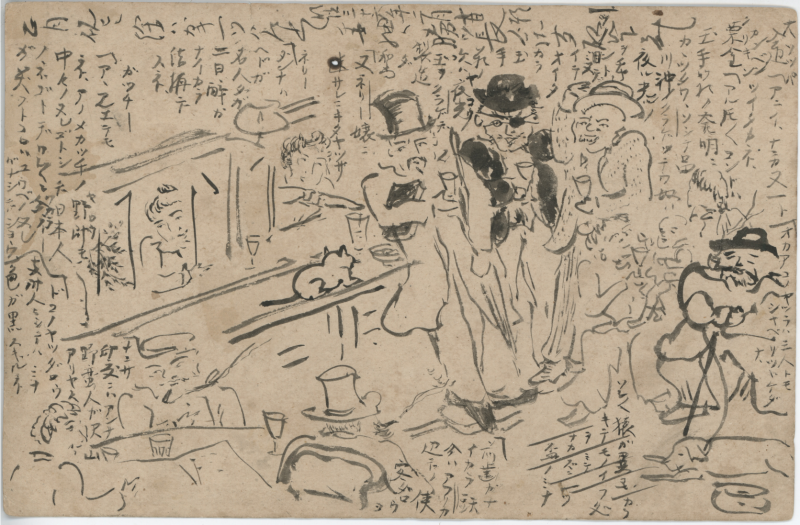
Fig. 4 While Warburg was traveling in the United States, the Japanese folklorist and biologist Minakata Kumagusu was working at the British Museum in London (Tanaka). In 1903, Kumagusu drew a caricature of himself wearing a silk hat at a London pub. Image source: Minakata Kumagusu Archives (Tamura, 2013).
I have put these thoughts here because, while writing about Warburg, I returned full circle to wondering about the very identity of the "I" writing here. There is something about Aby Warburg that makes one ask oneself "Who on earth am I?". When I began researching him for some long-forgotten reason, I had no idea that I would end up following such an intricate, maze-like path.
My departure point is modern architectural history, in particular that of Germany. Attracted by Walter Benjamin, I shifted to urbanism and artistic theory, then was drawn gradually to the existence of Aby Warburg, who worked in the margins of the academy. Perhaps there was an elective affinity with Jewish intellectuals at work. This, along with my interest in the science of "the margin", the border regions, are related to the question "Who am I?". (Those who have read this book should understand that this is not the so-called pursuit of "identity.") For me, this question cannot be separated from questions of how to understand the topos called Japan and of what memories can be recalled from it.
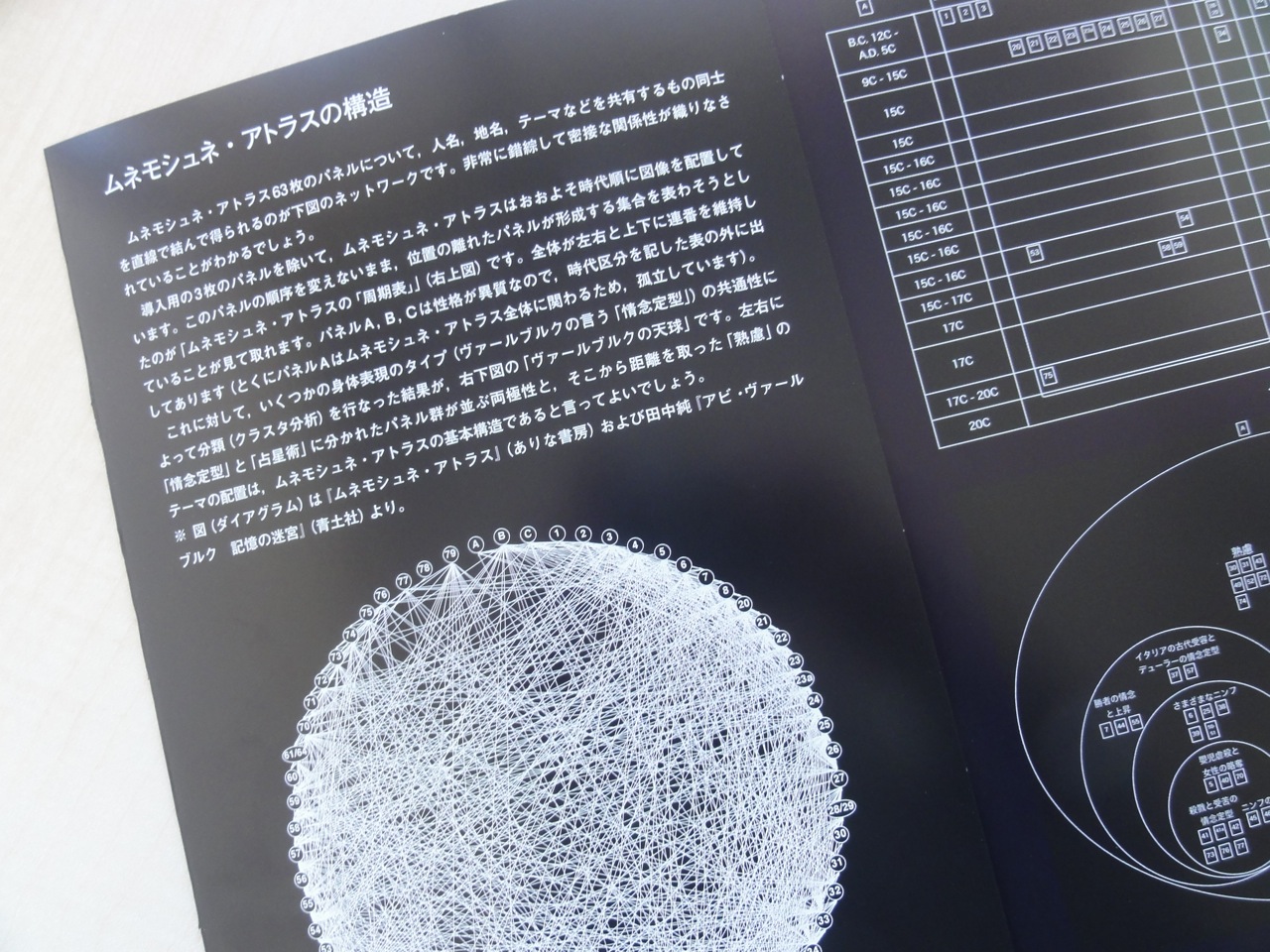
Fig. 5 A detail from the catalogue Atlas Coelestis produced by Jun Tanaka for the University of Tokyo exhibition of Mnemosyne Atlas reproductions, MNEMOSYNE ATLAS: Aby Warburg’s Cosmos of Images, 2012. Image source: University of Tokyo.
A considerable amount of writings on Warburg already exists in Europe and North America. For convenience, these can be divided into two categories: "biographies" and "theories of practice". There has been much biographical research based on solid evidence in Germany in recent years; the results of this research have been employed throughout this book. However, the book also prides itself in taking up issues not addressed in other writings on Warburg. Beginning with Georges Didi-Huberman, Warburg studies in France and North America tend to emphasize a methodological "revival of Warburg" as a criticism of iconology in the vein of Erwin Panofsky. I have some objections to the finer points of this discourse, but I too share this methodological concern.
However, biographical research finely divided into specific themes and a not entirely apolitical and unstrategic "revival of Warburg" do not answer my questions. Such manners of questioning may not be necessary for those who ask those questions. But we have lost something in this apparent linguistic and cultural "nearness" to Warburg. And I now think that the reason a speaker from a foreign land got into a reckless attempt to tell the tale of Warburg's intersection of madness and knowledge was because of the non-specific "nostalgia" and "homesickness" of a limitlessly weak "wordless one (infans)" that float about behind apparent "farness" and obvious difference. These emotions tried to wake memories sleeping deep within my own heart (Fig. 5).
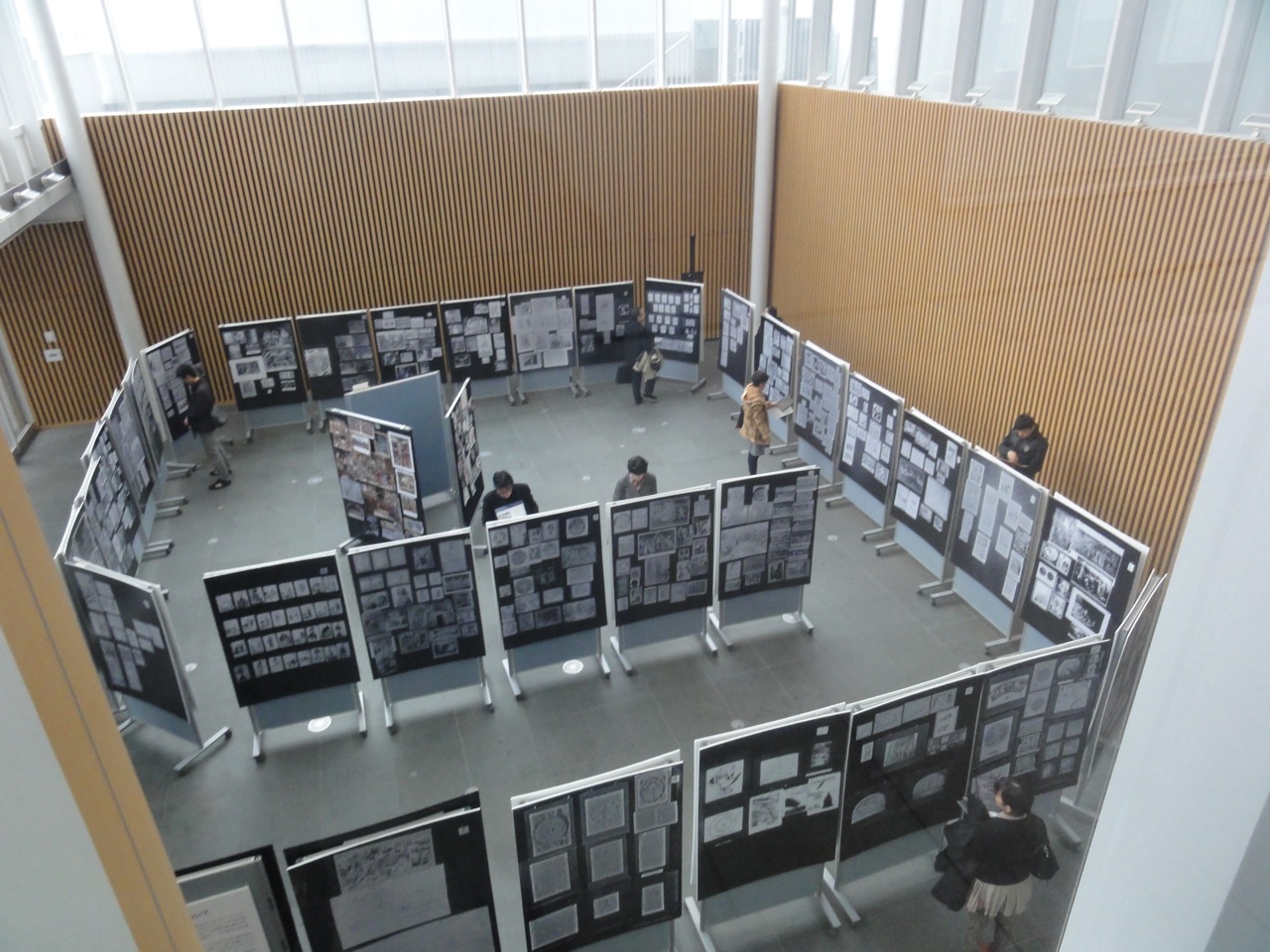
Fig. 6 An aerial view of the exhibition infrastructure created for display of Mnemosyne Atlas reproductions. MNEMOSYNE ATLAS: Aby Warburg’s Cosmos of Images, 2012 organized by Jun Tanaka at the University of Tokyo. Image source: University of Tokyo.
Thus I needed to come to face with Aby Warburg the man. E. H. Gombrich's biography was my best aid in doing so. To this day, it remains the greatest accomplishment in combining "biography" and "methodology". My own book is no more than a branch grafted onto its side. Through it, I have attempted a deconstruction of the image of Warburg that Gombrich depicted, and indeed, such an attempt could only occur in regards to one's object of deepest respect. In this light, my own book is also an homage to Sir. Ernst Hans Gombrich.
And yet it may have been ultimately myself who was deconstructed in this attempt. I have never before experienced the act of writing as a formality of passage so keenly as I did this time. "The attempt to know the past is one kind of travel into the world of death": these words of Carlo Ginzburg ring in my head. This book takes Warburg's "madness" as its theme, yet because access to the materials from Warburg's period of mental illness is limited, there are issues that the book does not address. Similarly, giving voice to the entirety of the rich volume of materials in the Warburg Archive and writing a biography that would replace Gombrich's are dreams that far surpass my scope of ability today. And yet, even if this book takes only a fragment of the great archive, I believe that painstakingly bending an ear to the murmurs uttered by the fine points of the text has allowed me to bring out an image of Warburg. This image appears in the designs woven by these murmurs, and had not existed until now. I would like to believe that its meaning lies in this. (I hear that Warburg's works are currently being translated into Japanese. My book preceded their publication.) At any rate, I have done what needed to be done, and I have no regrets in this respect. Now that I have finished this passing-through, a passage similar to following a dark road where the destination is unclear, I feel as though I have finally seen the "image" of Warburg the man (Fig. 6). And so from here on, the questions to be asked concern less Warburg than they do myself (Fig. 7).
TANAKA Jun
August 2001, on the night of the Perseid meteor stream.
Postscript
Aby Warburg wrote in the letter to Paul Warburg at October 6, 1926, as follows:
Gestern war auch noch der Besitzer eines grossen japanischen Warenhauses, Okura aus Tokio, hier; er ist ein sehr feinsinniger Philanthrop, der das Schul- und Bibliothekswesen in Japan wieder mit den alten geistigen Elementen durchdringen möchte. Er hatte seinen Architekten mitgebracht, um aus der Konstruktion meiner Bibliothek allerlei zu lernen; schade, dass ich niemals sehen werde, was dabei herauskommt: "Les idées d'un Hambourgeois vues par le tempérament d'un Japonais".
I found out that this "Okura" was OKURA Kunihiko, the president of a paper company and the founder of Okura Institute for the Study of Spiritual Culture, found in 1932. The building of the Institute remains in Yokohama until now. Its photographs can be seen on page 247 of my book. Figure 5 is the main building of the Institute in the style of eclectic pseudoclassicism. Figure 6 is the entrance hall of the building. Its name is "Hall of Spirit". Lions and Eagles are the symbol of gods and Buddha who always watch us from all directions. As far as I have investigated, it seems that there were no direct influence from KBW on the Okura Institute. [JT]
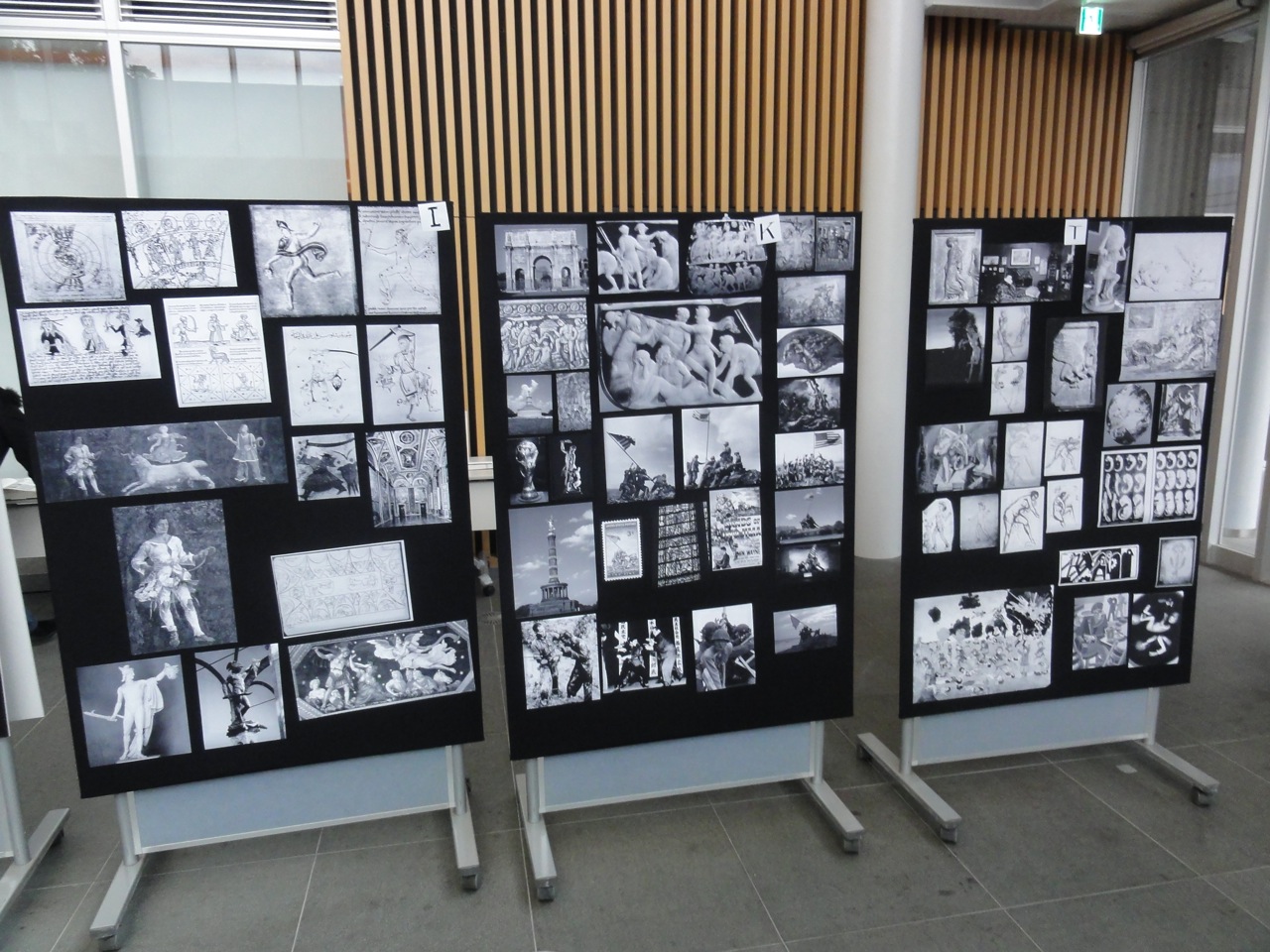
Fig. 7 A view of the three “MA[Mnemosyne Atlas]-like panels” created by Jun Tanaka for the exhibition MNEMOSYNE ATLAS: Aby Warburg’s Cosmos of Images, 2012 organized by Jun Tanaka at the University of Tokyo. Image source: University of Tokyo.
Abstract
On the night of the Perseid meteor stream, Japanese scholar Jun Tanaka wrote in acknowledgments to his book Aby Warburg: Kioku no Meikyu (Aby Warburg: The Labyrinth of Memory, 2001) that attempting to write a deconstruction of twenty-first century Europe’s image of German-Jewish scholar Aby Warburg ended up being a kind of rite of passage, a “passing-through” about his own experiments with biography and methodology in Japan. For Tanaka, Warburg became the wandering monk, or waki, a principal character in Noh theatre who crosses time and space in a replay of memories. Tanaka describes his association of Warburg’s Mnemosyne project with one particular Noh play, Izutsu and speculates on how the “dance of ghosts” that he asserts Warburg stages in his Mnemosyne project might have developed across trajectories of east-west exchange had Warburg followed his initial plans to travel to Japan in 1896, rather than remaining in the American West. In her introduction to Tanaka’s extracts – which include a late letter from Warburg to his brother Paul about Hamburg affinities in architectural ornament on a Japanese warehouse – Emily Verla Bovino compares Tanaka’s theatre of Noh association with Warburg’s Mnemosyne, to French Warburg scholar Philippe-Alain Michaud’s interest in what Warburg might have learned from Kabuki. These two kinds of classical Japanese theatre – Noh and Kabuki – are typically defined by scholars in a polarity that would undoubtedly have intrigued Warburg.
keywords | Mnemosyne Atlas; Warburg; Performance; Gesture; Artistic act; Theatre; Ghost Dance; Book extract; The Labyrinth of Memory; Jun Tanaka.
Per citare questo articolo / To cite this article: E.V. Bovino, A Ghost Dance in the Ripples of a Well Cradle. Jun Tanaka’s Aby Warburg: The Labyrinth of Memory (Tokyo 2001), “La Rivista di Engramma” n. 130, ottobre/novembre, pp. 240-251 | PDF